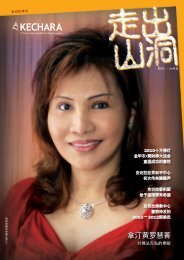You also want an ePaper? Increase the reach of your titles
YUMPU automatically turns print PDFs into web optimized ePapers that Google loves.
no.more.caves<br />
The International Memo For Today’s Spiritual Seeker<br />
For In-House Circulation & Non-Muslims Only/Not For Sale<br />
October - December 2007<br />
<strong>Twenty</strong> <strong>Three</strong><br />
As spoken by HE. Tsem Tulku Rinpoche<br />
Our sadhana (daily prayers) might be<br />
one hour a day. But the time that we are<br />
actually thinking, acting and associating<br />
with others is 23 hours, and these 23<br />
hours are much more important than the<br />
one hour we’re doing our sadhanas.<br />
When we’re doing our sadhanas,<br />
we’re reciting prayers so we can’t say<br />
many negative things with our speech;<br />
or we’re thinking about some Dharma<br />
subject. Also, we can’t do much with our<br />
bodily actions because we have to keep<br />
still while we’re doing our sadhanas,<br />
whether we’re sitting on the chair, in<br />
meditation in front of our altar, on the<br />
bed or on the sofa. So to some degree,<br />
our body, speech and mind are focused<br />
on the <strong>Three</strong> Jewels.<br />
But when we are out of our sadhana,<br />
during the 23 hours – that is the most<br />
dangerous. That is when we’re lazy, we<br />
don’t want to push ourselves or we’re<br />
engaging in negative actions, or in no<br />
actions. The time that we’re out of our<br />
sadhana is the time when we create more<br />
negative karma. Doing our sadhana is to<br />
correct our motivation – to think about<br />
the Dharma, about why we’re here,<br />
about what we’ve learnt, about our own<br />
actions, to contemplate about cause and<br />
effect, to think about what we want to<br />
do when we’re out of our sadhanas.<br />
The sadhana is not the real Dharma<br />
practice. The time out of the sadhana<br />
is the real Dharma practice because<br />
that is how we really are: how we deal<br />
with things when we get upset or when<br />
disasters happen, how we act and<br />
behave when we’re not being watched,<br />
how we carry out our responsibilities.<br />
The time we are off our meditation<br />
cushion is the real time when we’re doing<br />
our sadhana. Sadhana actually means to<br />
self generate or change oneself so during<br />
our meditational time we’re transforming<br />
into a deity, we’re transforming into a<br />
Buddha. Therefore, it’s when we’re out<br />
of our sadhanas that we act out what we<br />
have been “doing” during our sadhanas.<br />
When will we actually act out the<br />
prayers, the aspirations, the motivations<br />
we’ve created during our sadhanas?<br />
Another life? Another year? Another<br />
time? No. We do it immediately when we<br />
finish our sadhanas.<br />
Therefore, if we push ourselves every<br />
day for 23 hours, we make effort, make<br />
ourselves aware and become people who<br />
are very caring and loving, then we gain<br />
attainments when we do our sadhana.<br />
Why? With the 23 hours we create the<br />
merit and we destroy our habits. If we<br />
think the one hour of doing our sadhana<br />
is enough to gain attainments and the<br />
23 hours don’t matter, we’re absolutely<br />
wrong. Some people do their sadhanas,<br />
lots of retreats and meditations for years<br />
but they don’t gain any results – it’s<br />
because for 23 hours during the day, they<br />
haven’t changed.<br />
One hour of our sadhana is not<br />
meant to cover the 23 hours in the<br />
day. The 23 hours is training ground<br />
for that one hour. So, if for 23 hours<br />
we’ve been holding our vows, pushing<br />
effort, apologising, been kind and<br />
generous, we’ve been supplying, we’ve<br />
been sponsors, we’ve been helping<br />
others, giving food, giving love, teaching<br />
the Dharma, experiencing, creating<br />
happiness, giving advice for working in<br />
the Dharma and promoting the Dharma,<br />
then when we sit down and do our<br />
sadhana, it’s very powerful.<br />
It is the 23 hours out of the sadhana<br />
that count whereas your sadhana is<br />
just one hour. That’s just seven hours a<br />
week. There’s another 141 (23 x 7) hours<br />
a week that you’ve wasted. So, what’s<br />
more powerful? 141 hours a week or<br />
seven hours a week? Now you think.<br />
The hour that you’re sending love out<br />
to people every day, forgiving, crying,<br />
thinking about the Buddhas, doing the<br />
long life prayers and migtsema is only<br />
about seven hours a week. That’s only 28<br />
hours a month compared to what could<br />
be 560.<br />
This article is an extract from the<br />
Dharma talk “23”given by Tsem<br />
Tulku Rinpoche during a bookclub<br />
teaching in June. The editor has<br />
tried to maintain the essence of<br />
the talk but for the convenience<br />
of the reader, it has been edited<br />
down for brevity and lightly<br />
edited for grammar.<br />
Full audio and video files of this<br />
talk is available for download<br />
online at www.tsemtulku.com/<br />
dharma/teachings.htm
INner Dharma<br />
From the Editors<br />
Look who we<br />
found in Beijing!<br />
Dear readers,<br />
A breathtaking pilgrimage to three<br />
spiritual power places in China left<br />
the both of us awed, inspired and<br />
really quite shocked at just how large<br />
Buddhism was back in history. As<br />
our Lama HE Tsem Tulku Rinpoche<br />
constantly reminds all the Chinese<br />
among us in the centre, Buddhism<br />
is already a part of our culture, our<br />
history. The most pleasant surprise<br />
was to find the prevalence not just<br />
of Tibetan Buddhism there, but also<br />
of Tsongkhapa’s lineage in particular.<br />
(Read all about it on Pages 8 & 9).<br />
The constant, compassionate<br />
guidance of Rinpoche’s Gurus and the<br />
Protector has led him to Malaysia, with<br />
the larger vision of bringing Dharma to<br />
China. A part of our trip there was to<br />
find the best ways of travelling there,<br />
in preparation for when Rinpoche’s<br />
teachings do reach Chinese shores.<br />
And yet, while it is always grand<br />
and good to have bigger visions, we<br />
may just be falling flat on our faces<br />
if we can’t handle it. Are things<br />
efficient and organised enough back<br />
home? Are we ourselves, as students,<br />
representing our Lama well enough to<br />
be taking him abroad?<br />
This issue of nmc puts a particular<br />
focus on things back here on home<br />
ground – first, an insight into the<br />
role of the liaisons seeks to give<br />
people a better idea of how the<br />
<strong>Kechara</strong> organisation works, and<br />
also to debunk the many myths and<br />
misconceptions about “what the<br />
liaisons actually do.” Also, this is the<br />
first in a series we hope to introduce<br />
to nmc, where liaisons themselves<br />
write a piece on their experience<br />
within the <strong>Kechara</strong> House mandala.<br />
We also urge you to please<br />
spend time reading the article<br />
about the ladrang (page 6), a<br />
Lama’s household, and its vital<br />
importance in any monastic or<br />
spiritual organisation. As<br />
the crucial pivot of the<br />
centre, it is often regarded<br />
as the head that leads the<br />
body; and without our<br />
total support of this head,<br />
the rest of the body cannot<br />
function to the best of its ability.<br />
Remember constantly that none<br />
of what we have in Dharma would<br />
be possible without the Lama and<br />
his household. If we love our Guru,<br />
the centre and wish for its growth to<br />
benefit many, we need to realise the<br />
importance of the ladrang and support<br />
it wholeheartedly, in whatever means<br />
we can.<br />
Of course, a part of this support<br />
also comes from our own practice<br />
and inner transformation – the best<br />
way of representing our Lama and<br />
bringing him to the world. The other<br />
articles in this issue looks at how<br />
<strong>Kechara</strong> members and friends are<br />
taking things up a notch. Read about<br />
our new <strong>Kechara</strong> House extension<br />
that allows for far greater expansion in<br />
An antique statue of the 7th Dalai Lama<br />
at Yung He Gong Monastery, Beijing.<br />
Dharma activities (Page 3), KMP’s first<br />
public Dharma sharing with another<br />
local Buddhist society (Page 11), the<br />
growth of our community initiative, the<br />
<strong>Kechara</strong> Soup Kitchen (Page 12) and<br />
the development of Dharma houses<br />
and spiritual communities to strengthen<br />
practitioners’ focus (Page 7).<br />
We sign off this year’s last issue with<br />
a big flourish as new stepping stones<br />
appear and we charge up our spiritual<br />
ammunition to bound ahead. The<br />
future’s bright, the future’s shiny and<br />
all we see are yellow hats.<br />
Much prayers,<br />
Jamie and Joe<br />
GET ONLINE!<br />
Some of the articles in this issue of nmc are also available online but have been edited here for<br />
brevity and style. For the full, unedited versions of the articles, please refer to the websites, as<br />
indicated by , found at the bottom of all articles which appear online.<br />
We want to hear from you!<br />
nmc is brought to you by <strong>Kechara</strong> House Buddhist Association. For more information about <strong>Kechara</strong> House, its branches and activities, please contact any of the liaisons (Tsem<br />
Tulku Rinpoche’s personal assistants) • Ruby Khong (Personal Affairs/Outlets) rubykhong@yahoo.co.uk, 012 203 33373 • Henry Ooi (Business /Foreign Affairs) ooihenry@<br />
yahoo.com, 012 216 0126 • Paul Yap (Artistic Development /Travel) szekekyap@yahoo.com, 012 364 9797 • Joseph Chan (CEO, <strong>Kechara</strong> Media and Publications) xiaojoe@<br />
yahoo.com, 012 309 1785 • Susan Lim (COO <strong>Kechara</strong> Media and Publications) susanlim2007@yahoo.com, 012 405 5564 • Datin Ng Wee Chin (Special Projects/Finance)<br />
lowweechin@yahoo.com.sg, 03 5122 5128 • Ngeow Voon Chin (Strategic planning / Corporate & Legal Affairs /Dharma Education) ngeowchin@yahoo.com, 016 605<br />
2996 • Wan Yingkwachat (Outlets/Art) wasukamol@yahoo.com, 012 282 1030 • Chia Soon Peng (Outlets/Spiritual Affairs (external)) 012 309 0455 • Loh Seng Piow<br />
(New Media/Research) sengpiow@yahoo.com, 012 320 1460 • Tashi Caduff (Tsem Ladrang) tashipema@yahoo.de, 017 369 7070 • JP Thong (Tsem Ladrang) jpthong@<br />
yahoo.com, 012 207 3503.<br />
Who’s who in the cave<br />
• Spiritual advisor: H.E. Tsem Tulku Rinpoche • Editorial advisor: Joseph Chan • Editor: Jamie Khoo • Contributors: JJ Chong, Kelvin Hong, David Lai, Susan Lim,<br />
Sharon Saw and Andreas Uetz • Photography: Jamie Khoo, Loh Seng Piow, Cris Tan • Designer: Rosalind Tann • Printer: Les Couleurs Communication Studio.<br />
<strong>Kechara</strong> House, Lot 41 2a & 2b, Jalan PJU 1/3C, Sunwaymas Commercial Center, 47301 Petaling Jaya, Selangor, MALAYSIA. t: + 603 - 7806 4582 f: + 603 - 7804<br />
5862 e: kh_info@kechara.com w: www.kecharahouse.com
<strong>Kechara</strong> House Expansion<br />
INner Dharma<br />
<strong>Kechara</strong> House has grown!<br />
Time to spread our wings! <strong>Kechara</strong> House’s extension is now complete, paving the way for<br />
great new Dharma activity and work.<br />
By Sharon Saw<br />
Finally, almost exactly a year after the<br />
<strong>Kechara</strong> House Expansion Committee<br />
was formed, the <strong>Kechara</strong> House<br />
extension has materialised.<br />
The usage of space has evolved<br />
over time. We had originally planned<br />
to have a retail outlet on the ground<br />
floor, which would be an extension of<br />
Dzambala Mystical Treasures. However,<br />
it was decided that as the area was<br />
quiet, especially in the evenings, it was<br />
not practical to have a retail outlet<br />
there. Fortunately, the fittings had not<br />
been constructed for the retail area yet<br />
so we could change the design with no<br />
extra charge!<br />
Buddha Oasis, the multi purpose hall<br />
area, and Setrap Chapel became bigger.<br />
We also designated an office for our<br />
new KH Administrator, Paulyne Leong.<br />
At the entrance, there is a comfortable<br />
reception area with a TV so people can<br />
relax and watch Rinpoche’s teachings.<br />
In September, Lord Setrap was invited<br />
to its bigger chapel in the KH extension.<br />
It took a whole evening and many<br />
volunteers to remove Setrap’s pearls<br />
and vestments, which then had to be<br />
cleaned before he was invited over to<br />
the new extension. Amazingly, when<br />
Margaret took Setrap’s clothes to the<br />
dry cleaners, the dry cleaner offered to<br />
clean them for free when he heard they<br />
were a Buddha’s clothes!”<br />
We have also received a great<br />
deal of kind sponsorship. Mr. Yeo of<br />
Ying Shun Enterprises donated beds,<br />
wardrobes, bedside tables, conference<br />
tables, chairs, sofas and bar stools<br />
for the hostel and Buddha Oasis. Lee<br />
Ho also sponsored two air con units,<br />
a fridge and microwave oven for the<br />
hostel. In addition, Mr. Morgan Ho from<br />
Moon Light, sponsored the blinds for<br />
the hostel and sound room while Mr.<br />
Ong Chong Hup of GLP resources (M)<br />
Sdn Bhd sponsored the wall paints for<br />
the hostel. A big thank you to all of<br />
them!<br />
The KH extension manifested from<br />
the funds raised and sponsorship of<br />
KH’s beautiful new<br />
Dzambala Chapel.<br />
generous donors, the hard work of the<br />
renovations team, headed by Margaret<br />
Lee and Liaison Ruby Khong, assisted<br />
by Chuah Su Ming, Uncle Lai, and many<br />
others. We would also like to extend a<br />
big thank you to Koon, the contractor,<br />
and his team who have been patient<br />
and helpful throughout the project.<br />
Above all, we should remember that<br />
this growth is the inspiration of our<br />
Lama, HE Tsem Tulku Rinpoche, and we<br />
should continue to create the causes for<br />
him to turn the wheel of Dharma.<br />
While the KH extension is complete,<br />
we still have to return the friendly loans<br />
of around RM150,000 as well as service<br />
the bank loan, approximately RM5,000<br />
a month. As such, we still need your<br />
support so please contribute to our KH<br />
expansion fund and support our fund<br />
raising events!<br />
www.tsemtulku.com<br />
Raising the bar on fundraisers<br />
2-day Setrap puja, July 2007<br />
As advised by Tsem Tulku Rinpoche, a huge two-day Setrap puja was conducted at<br />
the end of July as a thanksgiving to Setrap for our having completed the 10 million<br />
migtsema recitations. It was combined as a fundraising initiative for KHEC, where<br />
participants were individually sponsored by friends and family to do the puja. Pujagoers<br />
also had the opportunity to make precious offerings to Setrap during the puja,<br />
and Rinpoche himself very kindly personally blessed a large number of the offerings.<br />
The puja raised over RM70,000 for KHEC.<br />
Showtime! Variety Show, August 2007<br />
Showcasing some of the city’s most beloved, fun-loving celebrities and artistes,<br />
Showtime! brought the stars into our eyes in a highly entertaining two-hour<br />
performance. Fashion designer Bill Keith and DeeDee of Jangan Ketawa fame put<br />
together a hilarious show as the show’s endearing hosts, and the audience were<br />
treated to stellar performances by celebrities like Dia Fadillah, Salamiah Hassan,<br />
Eric Choong and our very own KH stars, JP Thong, James Long and <strong>Kechara</strong> House<br />
models! For all the crazy obstacles that came up in the planning stages, Showtime!<br />
was smooth sailing and immensely successful, bringing in RM40,000 for our new<br />
extension and Tsem Ladrang.”<br />
Our deepest thanks to everyone who volunteered and supported our fundraising<br />
events. Your support will go a long way in helping the growth of our Dharma<br />
activities now and in the future.
INner Dharma<br />
Turning the wheel of Dharma<br />
Liaisons and KH President take vows<br />
for the Dharma in Setrap’s Chapel<br />
Right Hand Men<br />
Just who are the liaisons? And what do they really do?<br />
We take a look at the important, pivotal role of liaisons<br />
in the mandala of <strong>Kechara</strong> House.<br />
By Susan Lim<br />
The system of having liaisons was<br />
introduced to <strong>Kechara</strong> House in 2006.<br />
Thanks to the kind guidance of our<br />
spiritual advisor, HE Tsem Tulku Rinpoche,<br />
a system of having liaisons was put<br />
in place for the centre to function<br />
more efficiently and effectively on an<br />
operational level. The concept of this<br />
structure stems from the monastic<br />
institution of the great Gaden Monastery,<br />
which was adopted hundreds of years<br />
ago and endures until today.<br />
The position of a Head Liaison in<br />
the monastery is called the Chang Tso,<br />
who reports directly to the Abbot of the<br />
monastery. Each department head, or<br />
Sopon, holds a particular portfolio to<br />
support the Chang Tso by carrying out<br />
their respective duties. The positions of<br />
Chang Tso and Sopons are held in high<br />
regard in the monastery and require<br />
extreme dedication of highly trained<br />
monks who are fully responsible for all<br />
related matters in each department.<br />
To be appointed as a Chang Tso, or<br />
liaison, in the monastery is an incredible<br />
honour. By serving the Lama in this way,<br />
the liaison directly facilitates the growth<br />
and success of his Dharma work and<br />
teachings, and brings his spiritual wishes<br />
to fruition. In this most supreme form<br />
of serving the Lama, the liaison thus<br />
serves the entire <strong>Three</strong> Jewels directly, by<br />
contributing to the spread of Dharma to<br />
benefit others.<br />
Monks nominated or selected as<br />
Chang Tsos in the monastery do not<br />
refuse, for it is likened to refusing<br />
the entire Sangha. They are one of<br />
the <strong>Three</strong> Jewels in which one takes<br />
refuge, and so, refusing the position is<br />
equivalent to refusing one of the pillars<br />
in which we take refuge.<br />
Here in <strong>Kechara</strong> House, the Liaisons<br />
are committed to assisting Tsem Tulku<br />
Rinpoche in whatever ways are required to<br />
spread Lama Tsongkapa’s teachings far and<br />
wide. This includes supporting and creating<br />
the most suitable environment for making<br />
these teachings available to all who come<br />
into contact with <strong>Kechara</strong> House, and<br />
thus to prepare them for the deeper mind<br />
training embodied within these teachings.<br />
How Liaisons Are Appointed<br />
New liaisons are appointed when the<br />
need arises as Rinpoche’s work expands<br />
and grows. People with relevant<br />
experience and/or skills are identified by<br />
the current liaisons and presented in the<br />
liaisons’ meetings. The existing liaisons<br />
then democratically cast their votes and<br />
the proposed names are presented to<br />
Rinpoche for his blessings.<br />
The nominated person is then<br />
formally invited to accept the privileged<br />
position as a liaison.<br />
So What Does That<br />
Mean To Me?<br />
The liaisons also assist in arranging<br />
programmes and events for students,<br />
members and friends, and facilitating<br />
audiences with Rinpoche. They form the<br />
critical bridge between Rinpoche and<br />
the rest of the centre and its activities by<br />
relaying information between the two<br />
and implementing any necessary changes.<br />
Members may sometimes not really<br />
understand what liaisons do or who<br />
they are, or feel that they cannot be<br />
approached because they are too busy.<br />
Remember that the liaisons are students<br />
of Rinpoche and our Dharma brothers and<br />
sisters too and deserve our full support for<br />
their work. By showing them our moral<br />
support and offering to help them in their<br />
various departments and work, we directly<br />
help Rinpoche’s work and therefore, the<br />
growth of Dharma and the centre.<br />
Don’t be afraid to go talk to them as<br />
they are as much a part of the mandala<br />
as you are. Share your experiences in<br />
Dharma with them and listen to theirs<br />
– much can be learnt.<br />
By Jamie Khoo<br />
Who Are They?<br />
Under the auspices of His Holiness the 14th Dalai Lama’s birthday this year, five new<br />
liaisons were appointed to assist Rinpoche in various areas within the organisation.<br />
They are:<br />
1 Wan Yingkwachat - Liaison of Outlet and Arts<br />
2 Loh Seng Piow - Liaison of New Media and Research<br />
3 Tashi Caduff – Liaison of Tsem Ladrang<br />
4 JP Thong– Liaison of Tsem Ladrang<br />
5 Chia Song Peng – Liaison of Outlet and Spiritual Affairs<br />
Existing Liaisons<br />
1 Ruby Khong – Liaison of Personal Affairs and Outlets<br />
2 Henry Ooi – Liaison of Business and Foreign Affairs<br />
3 Paul Yap – Liaison of Artistic Development and Travel<br />
4 Joseph Chan – Liaison of <strong>Kechara</strong> Media and Publications (Chief Executive Officer)<br />
5 Datin Ng Wee Chin - Liaison of Finance and Special Projects<br />
6 Susan Lim – Liaison of <strong>Kechara</strong> Media and Publications (Chief Operating Officer)<br />
7 Ngeow Voon Chin - Liaison of Strategic Planning, Corporate & Legal Affairs and Dharma Education
Turning the wheel of Dharma<br />
INner Dharma<br />
A personal journey<br />
Kicking off this new series of insights from Rinpoche’s liaisons, <strong>Kechara</strong> Media and Publication’s<br />
liaison and Chief Operating Officer shares her personal experience in the mandala.<br />
By Susan Lim<br />
In October of 2006, Liaison Ruby<br />
Khong mentioned that the liaisons had<br />
been looking for the right candidates<br />
to assist Rinpoche in his work for a few<br />
months already.<br />
I offered to do it…if Rinpoche<br />
approved. Soon after, Ruby told me that<br />
I’d been approved to work for Rinpoche.<br />
I was elated but confident. Although<br />
I was born into a Theravadan Buddhist<br />
family, we were not practising Buddhists.<br />
When I was 11, I considered myself a<br />
Christian and in my teens, I immersed<br />
myself into Christianity while in the US.<br />
It wasn’t enough to just study and<br />
help in the church. For me, the only way<br />
to experience the qualities of God was to<br />
be a willing vessel. So at 21, I sought the<br />
blessings of my pastor and the over-1000<br />
member church to go to Africa as a solomissionary.<br />
When I returned to Malaysia<br />
in 2000, I fell into the expected route of<br />
getting a good job and did not spend as<br />
much time on spirituality as I had while<br />
overseas.<br />
When I met HE Tsem Tulku Rinpoche,<br />
I was captivated by his teachings. The<br />
more I listened and read, the more I<br />
wanted to experience the teachings<br />
and felt an intense draw towards it.<br />
When the opportunity came, I left my<br />
comfortable career with Intel to become<br />
one of the Ladrang Liaisons. Having been<br />
a missionary braving the African jungle,<br />
I thought I was ready for any situation. I<br />
was in for the surprise of my life.<br />
As Ladrang Liaisons, one of our duties<br />
was to ensure that Rinpoche’s personal<br />
needs were taken care of. I would do<br />
grocery runs in the mornings, before<br />
coming into work. We would make a list<br />
of items to buy so that the corporate,<br />
efficiency-obsessed freak in me wouldn’t<br />
have to get groceries everyday. But that<br />
never happened. Picking up items day in,<br />
day out, sometimes several times a day,<br />
got to me. I would try to figure out ways<br />
to ensure that this was reduced but it still<br />
didn’t happen. Rinpoche would change<br />
the menu on us but mostly it was because<br />
of our own blunders. Occasionally, we<br />
Susan, with Tsem Rinpoche,<br />
during the trip to Gaden last year.<br />
would have night food runs as well.<br />
Often, no matter what we did, we<br />
just couldn’t get it right. Attitudes<br />
flared under stress and more mistakes<br />
were made due to the lack of harmony<br />
and communication. I saw cause and<br />
effect at play right under my nose.<br />
My head was constantly buried under<br />
problems which needed solutions. I was<br />
running low on ways to work things<br />
out. Stress was building too because I<br />
held two portfolios – Ladrang Liaison as<br />
well as Liaison for <strong>Kechara</strong> Media and<br />
Publications. My time was supposed to<br />
be divided 50/50 but somehow I was not<br />
able to fulfill my duties in either place. I<br />
felt like a total failure and I was no help<br />
to Rinpoche at all.<br />
After 2 1/2 months, I felt I had taken<br />
up more than I could handle. I certainly<br />
had countless experiences but couldn’t<br />
quite make out what I had learnt or<br />
what I was supposed to be doing. Then I<br />
realised what renunciation might mean,<br />
and knew that I had a long way to go. My<br />
daily questions became clear to me, that I<br />
was still “checking” Rinpoche out. If I had<br />
full Guru Devotion, the questions would<br />
not even arise.<br />
I sought audience with Rinpoche<br />
and confessed my confusions. He was<br />
extremely gentle, and patiently listened<br />
and explained for close three hours. From<br />
his kindness, I understood a little bit more<br />
about my state of mind and was touched<br />
by how much care he freely gave. When<br />
my mind was calmer, he pointed out that<br />
nothing had changed since I walked into<br />
the room, but everything had changed<br />
because my mind had changed. How<br />
true. My first lesson on impermanence!<br />
Is Rinpoche really so demanding? Yes,<br />
he is, but not for himself. He demands<br />
transformation from us and that is why<br />
he remains with us, using so many skillful<br />
ways to help us learn. I realised that he<br />
never really needed the food to start<br />
out with. His skilful means allows us to<br />
gain merits. In his kindness, he creates<br />
opportunities for us to serve our Lama. He<br />
does not need serving at all or anything<br />
from us. In fact, he is the one who gives<br />
the most gifts, buys the most food and<br />
drinks for his students in all departments,<br />
stays up to teach and pray, the most<br />
giving of himself.<br />
Now I am with <strong>Kechara</strong> Media and<br />
Publications and the lessons continue.<br />
What I am able to do is very little but I<br />
do vow to support Rinpoche as much as<br />
I can. I highly encourage all to be great<br />
supporters of Rinpoche. As liaisons,<br />
we have assigned responsibilities to<br />
carry out. But in the end, we are all<br />
students of Rinpoche, and from that<br />
level, it doesn’t matter if we have any<br />
designations or titles.
INner Dharma<br />
Turning the wheel of Dharma<br />
The Ladrang: Our<br />
Lama’s household<br />
and the deities’ abode<br />
While the ladrang is the most important place in any<br />
Dharma organisation, it is the first place we tend to<br />
overlook. Here, a profound insight into why it needs<br />
our constant, unwavering support.<br />
By Andreas Uetz<br />
improved.<br />
There really is no limit to what becomes<br />
possible once we have fully understood<br />
the role of the Lama as the heart of the<br />
Dharma and the ladrang as the heart of<br />
the Dharma organisation.<br />
If, on the other hand, the ladrang<br />
doesn’t do well, the Lama doesn’t do<br />
well, then the teachings don’t do well,<br />
sponsorship doesn’t do well, and the<br />
Lama is eventually forced to return to the<br />
From the Lama’s actions, inspiration<br />
comes. From the Lama’s speech,<br />
attainments come. From the Lama’s mind<br />
blessings come. The Lama’s mind abides<br />
in the formless sphere of ultimate truth,<br />
the Dharmakaya sky, which displays<br />
the rainbow of enlightened qualities<br />
made visible through the Lama’s physical<br />
manifestation. The purer our view of the<br />
Lama, the more powerful the blessings we<br />
receive upon mere contemplation of his<br />
holy body, his kindness and his guidance.<br />
All of this is ideally seen and symbolised<br />
in the Lama’s household, the ladrang, which<br />
is, in truth, his yidam’s divine mansion, Pure<br />
Land and sphere of sacred power. When we<br />
scrub the Lama’s kitchen floor, we are not<br />
serving a person, but a deity.<br />
The ladrang is also a Dharma<br />
organisation’s headquarters, where new<br />
projects take shape from the Lama’s<br />
inspirations, where he prepares for his<br />
teachings, where advice and instructions<br />
are provided from the Lama’s meditations,<br />
where pujas are continuously performed<br />
for the well-being of the organisation and<br />
students, where meetings with liaisons<br />
and audience-seekers are held, letters<br />
dictated, trillions of SMS composed...<br />
If we make our Lama’s ladrang big,<br />
splendid and powerful, it acts as a divine<br />
magnet to pull vast numbers of people<br />
into his joyful care, and as an invaluable<br />
chance for many to support and help.<br />
The Lama’s ability to benefit living<br />
beings is limitless, yet it is the disciples’<br />
duty to make it visible and available to all.<br />
If the ladrang is big, the teacher is big;<br />
the number of recipients of teachings<br />
grows; the ensuing benefit grows big<br />
– big sponsors are attracted and the<br />
organisation can then grow exponentially,<br />
build retreat centres, chapels, outlets,<br />
recruit more professionals, support the<br />
mother monastery; new areas can be<br />
explored, existing ones expanded and<br />
Prolonging the Lama’s life<br />
Tsem Tulku Rinpoche recently recommended practices and prayers that can be done to prolong<br />
your Lama’s life. Apart from creating the causes for the Lama to live long and turn the wheel of<br />
Dharma, these prayers also directly help to extend the life of all Lamas, and to bring about all<br />
conducive conditions and resources for them to teach.<br />
www.tsemtulku.com<br />
The practice is as follows:<br />
• Invite any of the three Long Life Buddhas home – Namgyalma, Amitayus or White Tara.<br />
• If possible, we should encase the Buddha statue in a glass box, and place many offerings inside.<br />
Place a picture of your Lama in front of the Buddha.<br />
• We can offer butterlamps, sensory and water offerings in front of the images.<br />
• Before the image, and with the pure motivation of wishing for the Lama’s long life and success in<br />
his Dharma work, we commit to reciting 100,000 mantras of the long life deity, followed by 1000<br />
mantras a day thereafter.<br />
• Begin by taking refuge and doing your daily sadhana. Then recite the long life sadhana that has<br />
been compiled by <strong>Kechara</strong> House and the committed number of the long life yidam’s mantra.<br />
• As we recite the mantra, focus your prayers towards the growth and spread of Dharma<br />
teachings, for your Lama and all Gurus to live long, for them to have everything that they need for<br />
their work, and for all their wishes to be fulfilled.<br />
The long life deity prayers can be downloaded at www.tsemtulku.com<br />
Amitayus, Namgyalma and White Tara, the long life Buddhas we<br />
can propitiate for our Lama’s long life.<br />
monastery. Yet, the monastery’s purpose is<br />
to produce teachers who go out and help<br />
all beings attain freedom from suffering!<br />
Upon contemplation of this fact we see<br />
that the ladrang is even more important<br />
than the monastery.<br />
There is nothing more meritorious than<br />
to sponsor or serve one’s Lama. If we<br />
support our Lama, we indirectly help all<br />
those who are helped by him. Every single<br />
person that takes refuge with Rinpoche<br />
automatically becomes his responsibility<br />
until Enlightenment – even materially if<br />
necessary! Yes, it is a holy burden and yes,<br />
it is huge. May we help to carry it happily.<br />
Let’s make it our profound heart<br />
commitment to let our Lama’s teachings<br />
shine from here to everywhere. HE Tsem<br />
Tulku Rinpoche has saved, inspired and<br />
transformed so many lives already; let us<br />
serve him in extending his teachings and<br />
guidance to many, many more. And let us<br />
start by making his ladrang bigger than<br />
Buckingham Palace, and run smoother<br />
than a well-oiled pinball machine…<br />
“Even a single hair from your pores is<br />
for us a field of merit more highly praised<br />
than all the victorious Buddhas of the<br />
three times and ten directions,” as it is<br />
said in the Guru Puja…<br />
May Oceans Of Happiness Extend<br />
Everywhere
Living out<br />
INner Dharma<br />
When a house is more than a home<br />
A new phenomenon of Dharma houses has recently grown out of our spiritual<br />
community. We take a look at what it all really means for Dharma friends to live<br />
together.<br />
By Jamie Khoo<br />
As more and more Dharma houses<br />
spring up around the bustling suburb of<br />
Bandar Utama in Petaling Jaya, Dharma<br />
too grows, as the spiritual communities<br />
within find greater, incredible support<br />
and care for their individual and<br />
collective spiritual works and practice.<br />
When Heruka House first started in<br />
December 2005, it brought together<br />
a group of six Dharma friends in an<br />
unusual way that most of us had<br />
not seen before. Some traded in the<br />
comforts of living with parents, others<br />
left behind the hassles of renting alone<br />
to share a house together. More than a<br />
year on, this first venture out to creating<br />
our version of a local Malaysian Sanghaof-sorts<br />
has inspired another three<br />
Dharma houses to grow.<br />
The idea behind sharing a home with<br />
fellow Dharma friends and family is to<br />
help and support us in our spiritual paths<br />
and endeavours. Having lived in Gaden<br />
Shartse Monastery for over nine years,<br />
our Lama, HE Tsem Tulku Rinpoche, is<br />
especially keen to emphasise the benefits<br />
of living together with other Dharmicallymotivated<br />
people and to encourage<br />
more people to do the same.<br />
Rinpoche explains that by living with<br />
Dharma friends and through our support<br />
of each other that way, we directly<br />
create the karmic causes to be able to<br />
live in and do retreats with other spiritual<br />
aspirants in the future; ultimately, it<br />
creates the causes for us to live and work<br />
in a monastic community, as a member<br />
of the Sangha.<br />
“That is why thousands of monks and<br />
nuns live together in monasteries and<br />
nunneries,” explains Rinpoche. “If there<br />
was no benefit in communal spiritual<br />
living, Lord Buddha would not have<br />
instituted the living together of monks<br />
with monks, and nuns with nuns.”<br />
On a more “ordinary” level, Rinpoche<br />
points out that, “Living in a Dharma<br />
environment opens up more Dharma<br />
karma. People think that working for the<br />
Dharma and living with Dharma people<br />
might be too much, but actually we do it<br />
because there is a positive spiritual and<br />
caring environment. And it saves money<br />
too!”<br />
Dharma houses provide a kind of<br />
a spiritual sanctuary for practitioners<br />
to come home to and reside in peace,<br />
comfort and continual encouragement<br />
for their work and practice. Because<br />
these houses are created to strengthen<br />
our Dharma experience and learning<br />
process, they grow out of a natural<br />
environment of nurture and care, and<br />
the willingness to participate in and<br />
support each others’ aspirations.<br />
Most people are already living out<br />
independently and although it is not<br />
wrong to live with our non-Dharma<br />
friends, sharing a house with likeminded,<br />
similarly-motivated Dharma<br />
friends helps to ensure that we have<br />
strong, consistent support for the<br />
spiritual work and attainments that we<br />
want to achieve. It helps to keep us<br />
motivated, inspired, focused, encourages<br />
us to stay on the path and keeps us from<br />
wandering off a “wrong” way.<br />
After all, it is not unheard of for<br />
working professionals to flat-share; or<br />
for aspiring musicians and artists to live<br />
together. Living with peers who have<br />
all the same interests and goals as us is<br />
Jamyang House invites Manjushri<br />
into their Dharma home.<br />
nothing new; often, in fact, it pushes us<br />
to become better at what we do and to<br />
reach to our fullest potential.<br />
As David Lai, one of the “pioneers”<br />
of Heruka House shares, “We all learn<br />
to care for one another when any of<br />
us meet a crisis. This doesn’t happen<br />
everyday but when it does, all of us are<br />
always ready to help, we sit together to<br />
come up with solutions.<br />
“Being in a Dharma household also<br />
allows us to openly practise, make<br />
offerings to our Buddha statues and<br />
altars and engage in Dharma without<br />
offending anybody. Thus we live,<br />
work and do our practice within the<br />
Dharma.”<br />
Following Heruka House’s lead, Tara<br />
House, Jamyang House and Drakpa<br />
have also sprung into action in July,<br />
August and October this year.<br />
As Dharma takes off in the hearts<br />
and minds of many, we hope to see<br />
the beginnings of many more Dharma<br />
Houses, so that Gaden Monastery and<br />
the spiritual community of Sangha<br />
therein finds its own lovely, local<br />
manifestations right here in Kuala<br />
Lumpur. And thus, Dharma grows<br />
– physically and in our minds.<br />
www.tsemtulku.com
OUTer Dharma<br />
Journey to Enlightenment<br />
A grand pagoda overlooks BeiHai park and Beijing.<br />
Beijing’s Buddhist Heart<br />
In the first of a series that takes you into the heart of China’s most spiritually-charged<br />
power places, we travel to Beijing, where the emperors lived among Buddhas.<br />
By Jamie Khoo<br />
Behind the skyscrapers, the Chinese<br />
spitballs and the immense bustling of over<br />
a billion people, lies the quiet pockets<br />
of an ancient Dharma history. It turns<br />
out that Tsongkhapa, Tara, Maitreya,<br />
Yamantaka, Vajrayogini, Chenrezig all<br />
have exclusive holiday homes in China<br />
that not many know about… or rather,<br />
have forgotten.<br />
Four of us, Liaison Joseph Chan, JJ<br />
Chong, Kok Yek Yee and I, under the<br />
kind guidance and inspiration of our<br />
Lama HE Tsem Tulku Rinpoche, went on<br />
a mission to rediscover our Gelugpa roots<br />
in Chinese history. Rinpoche has often<br />
spoken about the prevalence of Tibetan<br />
Buddhism in China, particularly during the<br />
times of emperor Qian Long of the Qing<br />
dynasty and is always keen to remind his<br />
Chinese students that we are not doing<br />
anything new in Dharma; rather, the<br />
practice of Dharma brings us back to our<br />
very own cultural, historical, racial roots.<br />
The pilgrimage would mark one of<br />
<strong>Kechara</strong>’s first steps into “unchartered<br />
territory.” We would also be going to<br />
scout out travel arrangements which<br />
will facilitate future pilgrimages and<br />
trips organised for <strong>Kechara</strong>’s members<br />
and friends. And from there, we hope,<br />
it will eventually bring Rinpoche and his<br />
The white pagoda at Miaoying Temple<br />
teachings into China itself.<br />
Our pilgrimage would begin at Beijing,<br />
where we would visit Yung He Gong<br />
(the capital’s largest Tibetan Buddhist<br />
monastery) and other Tibetan Buddhist<br />
sites. We would then travel westwards<br />
to Wu Tai Shan, known to be Buddha<br />
Manjushri’s abode, and finally “back” to<br />
where it all began in Kumbum Monastery,<br />
QingHai, Tsongkhapa’s birthplace.<br />
And boy, were we in for an immense<br />
surprise. Even with all of Rinpoche’s<br />
reminders about Chinese’s spiritual past,<br />
we would never have expected Tibetan<br />
Buddhism to have thrived on such a huge<br />
scale in China, where religion has had an<br />
extremely quiet presence in the last half a<br />
century.<br />
Beijing was a particular surprise. In<br />
the midst of immense development and<br />
the build-up to next year’s Olympics, we<br />
discovered whole spiritual histories and,<br />
alongside it, a whole new generation of<br />
Chinese looking to revive it.<br />
Yung He Gong<br />
Yung He Gong’s origins were as a royal<br />
palace, during the reign of Emperor<br />
Yong Zhen, Emperor Qian Long’s father.<br />
After the death of Yong Zhen, when<br />
Qian Long became Emperor, the palace<br />
was converted into a monastery, which<br />
remains until today.<br />
“Lamaism,” as Tibetan Buddhism is<br />
referred to in China was the prominent<br />
religion during the Qing dynasty. The<br />
Gelugpa teachings and Tsongkhapa’s<br />
lineage in particular was what the<br />
Emperors themselves practised and had<br />
a great influence on the society. The<br />
governments of both Ming and Qing<br />
dynastries assisted this school, which<br />
caused the widespread practise and
Journey to Enlightenment<br />
OUTer Dharma<br />
teaching of Tibetan Buddhism throughout<br />
Northern and Western parts of China.<br />
While a lot of monasteries were<br />
destroyed during the Cultural Revolution,<br />
what remains is astounding in its beauty<br />
and the energy it still holds of hundreds<br />
of years of prayer. Yung He Gong holds<br />
an especially prominent place in what<br />
remains of Tibetan Buddhism because<br />
Zhao En Lai, the People’s Republic of<br />
China’s Premier at the time, personally<br />
saved it from destruction.<br />
Yung He Gong, like many of the<br />
Tibetan Buddhist monasteries in China,<br />
comprises different halls, linked together<br />
by small courtyards. And every one of<br />
the 13 halls reveals a whole new set of<br />
treasure. As the four of us ran up and<br />
down the monastery and through the<br />
halls, we did all we could to stop from<br />
screaming. It was just all too exciting.<br />
There, in the hallowed, dark spaces of<br />
another time, we found a most splendid,<br />
golden, smiling Tsongkhapa, an enormous<br />
Maitreya carved out of a single tree,<br />
Yamantaka, Tara, Manjushri, Kalarupa,<br />
Saraswati, Chenrezig…. and hundreds<br />
of fabulously ancient thangkas. (And the<br />
wonderful thing is that they even look<br />
Chinese – Buddhas with single eyelids and<br />
rosy, round cheeks).<br />
It seemed a little strange at first, to<br />
be seeing so much of what we associate<br />
as “Tibetan” right smack in the heart<br />
of China’s capital. But there they were<br />
– as Chinese as the chopsticks we’d<br />
eaten lunch with, looking comfortably at<br />
home as if that’s right where they were<br />
supposed to be.<br />
The White Stupa, Miaoying<br />
Temple<br />
Not far away from Yung He Gong,<br />
unassumingly tucked off on the side<br />
of a road, is a smaller, quieter temple.<br />
For all that it holds within though, we<br />
wondered why we were the only people<br />
there that day.<br />
Its heart is the white stupa,<br />
constructed back in the Yuan dynasty.<br />
The site for the stupa was personally<br />
surveyed and chosen by Kublai Khan<br />
and contains 22 pieces of Buddha relics,<br />
Qian Long’s personal writings of the<br />
Namgyalma mantra, Heart and Diamond<br />
sutras and his personal robes. It was<br />
further consecrated with representations<br />
of the Buddha’s body, speech and mind:<br />
Buddha statues, scriptures including the<br />
Kangyur and Tangyur, and holy relics<br />
taken from the four great mountains and<br />
holy sites throughout China are encased<br />
within the stupa alongside the relics.<br />
At the heart of the monastery, we also<br />
stumbled upon a hall filled to its every<br />
corner with 10,000 rare Tibetan antique<br />
Buddha statues, dating back to the Yuan,<br />
Ming and Qing dynasties. We were<br />
amazed at just how prolific the number<br />
and range of statues were, knowing well<br />
that this would only have been a mere<br />
percentage of what the temples would<br />
have held in its most flourishing days.<br />
Yong An Temple, BeiHai park<br />
BeiHai park is found just around the<br />
corner from the Forbidden City, and<br />
contains within it the tiny Qiong island,<br />
one of the earliest imperial Chinese<br />
gardens. The most prominent feature<br />
within this garden is the Yong An temple,<br />
the adjacent Tibetan-style stupa and the<br />
impressive Shan Yin Hall which houses<br />
a most unexpected surprise – a huge<br />
Yamantaka, who is believed to be the<br />
guardian of Beijing.<br />
Like most of the other temples in the<br />
city, the temple was built by an Emperor<br />
– the first Qing emperor, Fu Lin – and<br />
originally named the White Pagoda<br />
Temple. It was later renamed to Yong An<br />
temple by Emperor Qian Long, whose<br />
own writings were engraved on stone<br />
tablets and erected in the pavilions within<br />
the temple.<br />
The park and temple are now mostly<br />
overrun by tourists looking for a<br />
holiday photo but the majesty of<br />
the temple itself still remains. We<br />
were most thrilled with “spotting”<br />
Yamantaka in the little shrine atop<br />
a large set of stairs, sitting well<br />
above the dusty chaos of Beijing<br />
and sending his blessings out to an<br />
unknowing China.<br />
Hundreds of antique Buddhas,<br />
as far as the eye can see!<br />
Reviving Chinese Buddhism<br />
Now, Dharma teachings are scarce in<br />
China. Many of the devotees who visit<br />
these sites are full of faith and respect<br />
for the temples, but they seem to know<br />
little Dharma, having hardly any access to<br />
Dharma teachings. It seems a shame that<br />
the immense grandeur of these sites lie<br />
almost dormant now, that what we see of<br />
Dharma now is only a minute fraction of<br />
what it would have been at its peak.<br />
The few guides that we spoke to<br />
during our stay in Beijing and throughout<br />
China expressed ardent faith and deep<br />
respect for the religion, often being as<br />
keen to learn whatever they could from<br />
us, as we could from them.<br />
We spoke to a girl in Yung He Gong,<br />
Vivian Liy, who shared that, “Religion<br />
is very important to me. It can be like<br />
normal life and practised in normal life.”<br />
The law student, who was living in Beijing<br />
for her studies, also expressed her surprise<br />
that there were so many young people<br />
at the temple. She reasoned that it was<br />
because, “Everything in Beijing is now<br />
okay so people need to find something to<br />
satisfy the inside – spirituality.”<br />
Perhaps it’s time for us to bring it back<br />
there?...<br />
Catch the next chapter of our<br />
pilgrimage to Wu Tai Shan, in the<br />
next issue of nmc, coming in<br />
January 2008.<br />
Majestic<br />
Tsongkhapa in<br />
Yung He Gong
OUTer Dharma<br />
Talking shop<br />
Dato Dr Ng lends<br />
her support and<br />
goes shopping!<br />
<strong>Kechara</strong> House with Dagom<br />
Rinpoche in 2005.<br />
Re-opening<br />
its doors<br />
Our newly relocated <strong>Kechara</strong><br />
Mystical Treasures saw a grand<br />
opening in the heart of Bangsar’s<br />
thriving shopping hub.<br />
By David Lai<br />
It was not so long ago that <strong>Kechara</strong><br />
Mystical Treasures (KMT) first opened<br />
its red doors to a whole new frontier<br />
by establishing the presence of Dharma<br />
through retail. On April 1 2005 <strong>Kechara</strong><br />
Mystical Treasures was officially<br />
inaugurated by the Information Minister,<br />
Dato Donald Lim, at Piccolo Galleria in<br />
Kuala Lumpur.<br />
The only prank that April Fool’s<br />
day was upon our insecurity. Looking<br />
back, the outlet team really had no real<br />
experience in running a retail business.<br />
Challenges stemmed from everywhere,<br />
from the initial haphazard manner that<br />
the outlet was managed to the revolving<br />
(and inconsistent) volunteers who<br />
shifted in and out. In addition, the outlet<br />
also had to churn consistent earnings<br />
monthly to sustain the shop.<br />
The team learnt a lot since its<br />
opening, from experience and much<br />
critical feedback from customers, all<br />
the way up to direct guidance from<br />
Rinpoche, whose innovative idea it was<br />
to create these Dharma retail “temples”<br />
in town. In the process of growing, KMT<br />
brought with it the the inception of two<br />
other Dharma stores, Dzambala Mystical<br />
Treasures (DMT) and Yogini Mystical<br />
Treasures (YMT). <strong>Kechara</strong> outlets are now<br />
a big, wonderful Dharma family chain.<br />
KMT was also significant as the first<br />
unofficial base for <strong>Kechara</strong> Soup Kitchen,<br />
a <strong>Kechara</strong> community programme which<br />
began a year ago.<br />
However, two years after its launch,<br />
the management of Piccolo Galleria<br />
decided to convert the whole mall<br />
into a hotel and KMT had to relocate.<br />
Rinpoche’s Liaisons scoured the city<br />
to find promising locations. Through<br />
divination by our Lama HE Tsem<br />
Rinpoche, several places were deemed<br />
conducive for relocation but the most<br />
favourable was Bangsar.<br />
Then the headaches began! A<br />
multitude of obstacles cropped up; some<br />
came threateningly close to derailing<br />
the entire endeavor. However, through<br />
the courage and persistence of Liaisons<br />
Henry Ooi and Datin Ng (and of course,<br />
Lord Setrap!), obstacles were pacified<br />
and we were soon celebrating the grand<br />
re-opening!<br />
The preparation this time was on a<br />
massive scale as we had much more<br />
floor space to cover. Fortunately, we also<br />
had many more sincere volunteers who<br />
contributed their time to help this time. A<br />
whole battalion of dedicated volunteers<br />
Guests<br />
celebrate the<br />
opening of<br />
a beautiful,<br />
new KMT<br />
assisted in a whirlwind make-over of KMT<br />
on the eve of the opening. The whole<br />
event was organised by Liaison Ruby<br />
Khong, who is now a veteran at throwing<br />
such functions and events.<br />
Lama Tsongkhapa and Lord Dzambala<br />
statues arrived in time and as we closed<br />
for the night, Tsem Rinpoche came for a<br />
surprise visit to energise the outlet and<br />
clear unnecessary obstacles with a puja.<br />
The big day arrived, with many KH<br />
members dressed to the nines. Henry<br />
Ooi gave his welcome speech by briefly<br />
recounting <strong>Kechara</strong> outlets’ history and<br />
explained the origins of the items we<br />
have in the store. JP Thong, as the host<br />
of the day, then invited our VIP guest,<br />
Dato’ Dr. Ng Yen Yen, Deputy Minister of<br />
Finance I, for a short speech.<br />
Dato’ spoke of her own humbling<br />
experience of Tibetan culture with a<br />
guide she met in Qinghai, China, a<br />
province bordering Tibet. Dato’ shared<br />
that she was humbled by the simple<br />
way of life of the Tibetans who could<br />
live in nature and harmony, sharing that<br />
“there is much for the modern world to<br />
learn from Tibet”. She noted that the<br />
opening of the outlet is very beneficial<br />
for promoting tourism in line with the<br />
country’s positioning as a “Truly Asia”<br />
destination. Dato’ later purchased several<br />
jewellery pieces, one of which is going<br />
to be offered as a gift to the Queen of<br />
Malaysia!<br />
To celebrate the opening, there was a<br />
one-day sale which led to many draining<br />
their wallets and purses for fantastic<br />
treasures. The cashier counter was in top<br />
gear, and crowded for most of the first<br />
half of the day. At the end of the day,<br />
the sales figure totaled RM30k!<br />
The re-opening of <strong>Kechara</strong> Mystical<br />
Treasures was a tremendous success, and<br />
not just because of the sales or the VIP<br />
minister guest. Looking back, I thought<br />
it was the sheer determination, blood,<br />
sweat, tears and, ultimately, love that<br />
went into the outlets, all the way from<br />
the liaisons who worked so hard to<br />
the volunteers who put their devotion<br />
into action by rolling up their sleeves<br />
and volunteering their time and effort,<br />
coupled with the blessings of Rinpoche.<br />
www.tsemtulku.com
Dharma that Bites<br />
OUTer Dharma<br />
Andee (right) in action,<br />
while Bon translates.<br />
Taking teachings<br />
to the city<br />
KMP senior editor and writer Andreas Uetz gives his first<br />
Dharma sharing in Kuala Lumpur, to much applause and<br />
eager response.<br />
By JJ Chong<br />
One Friday, as many were rushing<br />
home from downtown offices, a<br />
small group of <strong>Kechara</strong> Media and<br />
Publication (KMP) staff and volunteers<br />
went downtown to the Bodhi Buddhist<br />
Society, near Puduraya, along with KMP’s<br />
full time writer and senior editor, Andreas<br />
Uetz (Andee), to share a talk on the Eight<br />
Verses of Thought Transformation.<br />
We were greeted by a Buddhist<br />
karaoke session, which was quite<br />
a cultural shock for some of us!<br />
Nevertheless, The Bodhi Buddhist society<br />
moved our hearts as they sang songs and<br />
hymns composed by some of their own<br />
members, in praise of the Buddha.<br />
The session was conducted in Chinese<br />
as most of the members were local<br />
university students from a Chinese<br />
educational background. There were a<br />
few senior members who took the lead<br />
in setting up the place, which included<br />
a unique altar with a Bamiyan Buddha<br />
statue standing within the background of<br />
a Dunhuang temple ruin.<br />
As the singing session came to a halt,<br />
the society’s president and co-founder<br />
Mr. Wong gave a short introduction<br />
about Andee to the crowd before inviting<br />
him up to share his talk with members of<br />
the society.<br />
As a mark of respect and gratitude for<br />
where he got his teachings from, Andee<br />
placed a framed photo of Tsem Rinpoche<br />
on the altar; this humility won the<br />
hearts of those present and gave a small<br />
glimpse of what Guru Devotion means<br />
in the Tibetan Buddhist tradition. Dharma<br />
brother, Bon, translated Andee’s sharing<br />
into Mandarin for the benefit of the<br />
Chinese crowd. Both Andee and Bon had<br />
prepared for this event for weeks and<br />
Andee had also met up with Mr. Wong<br />
to understand the workings of the Bodhi<br />
Buddhist Society.<br />
The session started off with Andee<br />
sharing with the crowd how fortunate it<br />
was for everyone to be there, compared<br />
to others who are not in the Dharma;<br />
that we should take full advantage of<br />
the opportunities we have to learn and<br />
practise the Dharma to transform our<br />
lives. He then gave a short explanation<br />
about his background<br />
as a music writer and<br />
composer, relating<br />
how his career<br />
brought him to<br />
Dharma, first through<br />
the Southern traditions<br />
of Thai Buddhism.<br />
He later found out<br />
more about Tibetan<br />
Buddhism when<br />
his girlfriend, Tashi,<br />
introduced him to her<br />
teacher, HE Tsem Tulku<br />
Rinpoche. He received<br />
an e-mail from Rinpoche with instructions<br />
to read and practise the Eight Verses of<br />
Thought Transformation. This blew his<br />
mind and moved his heart. Immediately,<br />
he cried in inspiration. The Eight Verses of<br />
Thought Transformation is the condensed<br />
form of Buddha’s most profound<br />
teachings on Compassion which<br />
Rinpoche had received from His Holiness<br />
the 14th Dalai Lama when he was only<br />
11. He too had cried throughout the<br />
teachings.<br />
Andee then began explaining the<br />
essence of the Mahayana thought of<br />
Buddhism, which the Bodhi Buddhist<br />
Society bases their study on, stressing<br />
that the term “Mahayana” is to liberate<br />
both ourselves and others to the state of<br />
Enlightenment. He gave the example that<br />
if we get sick, we beget suffering and<br />
sadness. But if we change the perspective<br />
around and take upon others’ sufferings<br />
and sadness as our own and provide<br />
happiness and comfort in return, it would<br />
bring hope to others.<br />
Andee then explained each verse in<br />
very simple terms. The audience was<br />
in awe of Andee’s presentation and<br />
enthusiastically received Bon’s animated<br />
translations.<br />
As the session approached the last<br />
verse, Andee shared that the Eight Verses<br />
can be made as a prayer to Kuan Yin,<br />
a promise we can make to her Divine<br />
Compassionate presence to enhance<br />
our lives with more Dharma and to<br />
improve our lives with the nourishment<br />
of Compassion. It is a promise we make<br />
to ourselves to improve and an offering<br />
to Kuan Yin that we may achieve her<br />
enlightened state.<br />
As the session ended with a dialogue<br />
between some of the members of the<br />
audience and Andee, there was more<br />
sharing of views, questions and answers.<br />
Mr. Wong then invited Andee to sing a<br />
number with his guitar. Andee<br />
was like a superstar! When<br />
he sang, those present were<br />
overawed with his singing and<br />
even filmed the entire song on<br />
their handphones!<br />
The evening ended with<br />
Mr. Wong presenting a token<br />
of appreciation to Andee on<br />
behalf of the Bodhi Buddhist<br />
Society and a song, “His<br />
Lovelit Image” which the<br />
Andee treats<br />
the crowd to<br />
some tunes.<br />
entire crowd sang in English<br />
as a gesture of appreciation<br />
for our participation.
OUTer Dharma<br />
Dharma in action<br />
The forgotten faces of KL<br />
As the <strong>Kechara</strong> Soup Kitchen extends its reach to help the homeless, they discover<br />
plenty of stories behind the many forgotten faces they encounter.<br />
By Kelvin Hong<br />
When we think about our KL, we<br />
recall the many acclaimed landmarks<br />
and sites that top the pages of tourism<br />
pages. In our free time, we might even<br />
have ventured into these hotspots for our<br />
shopping sprees, blind dates or lounging<br />
in cafes at the heart of KL. However,<br />
behind all the glitz and glamour that is<br />
the KL of today, there exists a pocket of<br />
homeless communities living on streets,<br />
alleys and sidewalks.<br />
And we have passed by them on<br />
many an occasion, without having done<br />
anything, have we not?<br />
A year ago, <strong>Kechara</strong> Soup Kitchen<br />
(KSK) was established under the<br />
guidance and inspiration of our Lama<br />
HE Tsem Tulku Rinpoche with the longterm<br />
vision of setting up a permanent<br />
soup kitchen to feed the homeless on a<br />
permanent basis.<br />
While the inception of the Soup<br />
Kitchen base has seen some challenges<br />
over the last year, pioneering members<br />
of KSK did not lose faith and continue to<br />
volunteer their time and services to this<br />
cause. And always, there are stories of<br />
the forgotten faces of KL that continue<br />
to inspire them to keep working.<br />
One Saturday, a group of KSK<br />
members comprising old and new<br />
volunteers ventured into Pasar Pudu to<br />
provide food to a group of homeless lot.<br />
The volunteers included team leader,<br />
Chuah Su Ming and her friends, Terence<br />
Tan, Ooi Beng Kooi, Pauline Chong,<br />
Kelvin Hong, Natalie Low and Erique<br />
Hew.<br />
Forget the charms of KLCC and posh<br />
bars. Here is a completely different<br />
picture of KL, a forgotten face to many.<br />
In the Pasar Pudu area, we see an<br />
aftermath of litter strewn around the<br />
streets by market vendors, rats running<br />
in and out of drains and rubbish. We<br />
see poor homeless souls sleeping by<br />
sidewalks under these conditions.<br />
However, the sight of this did not<br />
deter us and drove our determination<br />
even further to complete the mission that<br />
we had set out for that weekend.<br />
We started the evening by visiting<br />
an old Chinese man who was<br />
sleeping on a pavement outside<br />
a sundry store. According to the<br />
store owner, the man has been<br />
a regular there for a very long<br />
time. His face brightened as we<br />
offered him a packet of food<br />
and he muttered something in<br />
broken Chinese which we could<br />
not really understand, though we<br />
caught the words “thank you”.<br />
Among several other<br />
encounters, we met a homeless<br />
man who, according to Su Ming,<br />
was one of the most gentle and<br />
polite people she had ever come<br />
across on the streets. The Malay<br />
man, named Abdul Rahman<br />
but more commonly known as<br />
“Mann”, is in his 20s and living<br />
under a highway bridge.<br />
He shared that he used<br />
to work before but has now<br />
contracted HIV. Su Ming has<br />
been trying to get the AIDS foundation<br />
to visit him and offer him professional<br />
help which we are incapable of doing.<br />
When they told him that I had wanted<br />
to take a shot of him for my article, he<br />
quickly donned one of his best shirts to<br />
stand beside Beng Kooi for the shoot! He<br />
was a man of few words but spoke good<br />
English and appeared to be a very nice<br />
man indeed.<br />
As we ended the night, we realised<br />
that though we are living among some<br />
wonderful charms of KL, enjoying<br />
wonderful meals which we usually<br />
never finish, some people are a lot<br />
less fortunate. These people are living<br />
in conditions we would never have<br />
imagined in KL’s bustling heart. The<br />
people we encountered in Pasar Pudu<br />
don’t have proper homes or jobs, they<br />
have health issues and could be missing<br />
many meals every day. They could be<br />
dying anytime.<br />
Each time we see the light of a smile<br />
from the people we meet, it motivates us<br />
to return each week, knowing that we<br />
have created a small ounce of relief for<br />
them. It encourages us to believe that<br />
KSK volunteer Bob (top) stops<br />
to chat with a homeless man.<br />
our little effort could perhaps, be helping<br />
to prolong their life.<br />
But food alone is not enough. We<br />
are still striving towards establishing a<br />
permanent Soup Kitchen base to help<br />
the homeless on a more permanent<br />
basis. We want to ensure these people<br />
can continue to live happily despite their<br />
hardships and to embrace life with faith<br />
and hope.<br />
We encourage participation<br />
from all for our cause. Contact<br />
the following KSK members<br />
today for more details and<br />
contribute your time to help the<br />
needy and homeless in KL, every<br />
Saturday evening, from 6pm.<br />
1) Chuah Su Ming, 012-2911-178<br />
(Pasar Pudu/Chow Kit)<br />
2) Kennie Wong, 012-4590-130<br />
(Bukit Bintang)<br />
3) Kelvin Hong, 012-2938-958<br />
(Pudu Raya/Chow Kit)<br />
4) Beng Kooi, 012-3130-489<br />
(Chow Kit)<br />
5) Ben Thain, 019-2760-313<br />
(Pudu Raya/Petaling Street)



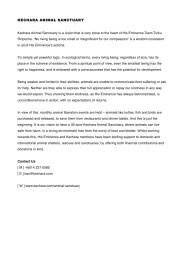

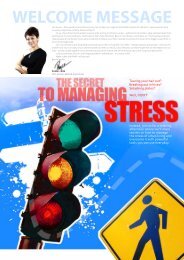
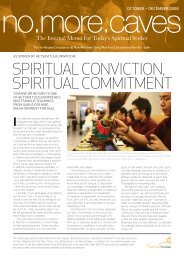
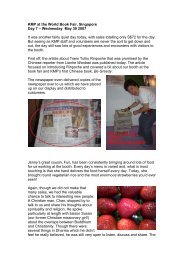
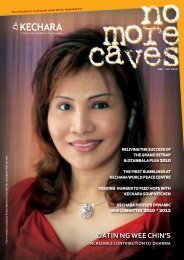



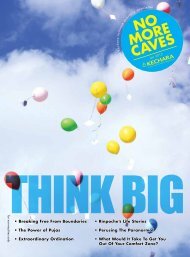
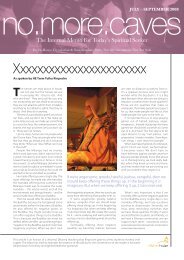
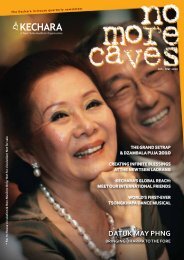
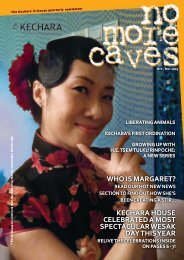
![7_NMC - OctDec09 [28Oct09] lowres.pdf - Kechara](https://img.yumpu.com/23793597/1/184x260/7-nmc-octdec09-28oct09-lowrespdf-kechara.jpg?quality=85)
